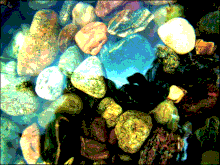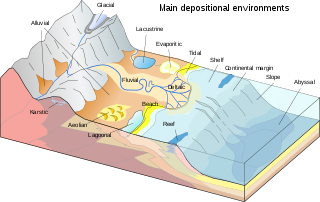

Roundness is the degree of smoothing due to abrasion of sedimentary particles. It is expressed as the ratio of the average radius of curvature of the edges or corners to the radius of curvature of the maximum inscribed sphere.


Roundness is the degree of smoothing due to abrasion of sedimentary particles. It is expressed as the ratio of the average radius of curvature of the edges or corners to the radius of curvature of the maximum inscribed sphere.

Rounding, roundness or angularity are terms used to describe the shape of the corners on a particle (or clast) of sediment. [1] Such a particle may be a grain of sand, a pebble, cobble or boulder. Although roundness can be numerically quantified, for practical reasons geologists typically use a simple visual chart with up to six categories of roundness:
This six-fold category characterisation is used in the Shepard and Young comparison chart and the Powers chart but the Krumbein chart has nine categories.
Rounding of sediment particles can indicate the distance and time involved [ citation needed ] in the transportation of the sediment from the source area to where it is deposited.
Speed of rounding will depend on composition, hardness and mineral cleavage. For example, a soft claystone pebble will obviously round much faster, and over a shorter distance of transport, than a more resistant quartz pebble. The rate of rounding is also affected by the grain size and energy conditions.
Angularity (A) and roundness (R) are but two parameters of the complexity of a clast's generalised form (F). A defining expression is given by:
F=f(Sh, A, R, Sp, T) where f denotes a functional relationship between these terms and where Sh denotes the shape, Sp the sphericity and T the micro-scale surface texture. [2]
An example of this practical use has been applied to the roundness of the grains in the Gulf of Mexico in order to observe the distance from the source rocks. [3]
Abrasion occurs in natural environments such as beaches, sand dunes, river or stream beds by the action of current flow, wave impact, glacial action, wind, gravitational creep and other erosive agents.
Recent studies have demonstrated that aeolian processes are more efficient in the rounding of sedimentary grains. [4] [5] Experimental studies have shown that the angularity of sand-sized detrital quartz can remain virtually unchanged after hundreds of kilometers of fluvial transport. [6]
Roundness is an important indicator of the genetic affiliation of a clastic rock. The degree of roundness points to the range and mode of transport of clastic material, and can also serve as a search criterion in mineral exploration, especially for placer deposits.
Alluvial debris in major rivers tend to exhibit a high degree of roundness. Alluvium from small rivers is less rounded. Deposits of ephemeral streams exhibit little rounding with angular clasts.
Pebble dikes are dikelike bodies found in intrusive environments, usually associated with porphyry-type ore deposits, which contain variably rounded fragments in a finely-ground matrix of pulverized rock. The clasts originate in deeper formations in hydrothermal systems, and have been brought up explosively by diatreme or intrusive breccias as groundwater and/or magmatic water flash boils. The clasts have been rounded due to thermal spallation, [7] milling action, or corrosion by hydrothermal fluids. [8] [9] The ore deposits of Tintic mining district [7] and White Pine mining district, and East Traverse Mountain, [10] Utah; Urad, Mt. Emmons, Central City, Leadville, and Ouray, Colorado; Butte, Montana; Silver Bell; and Bisbee, Arizona; and the Kiruna iron deposit in Sweden, Cuajone and Toquepala in Peru; El Salvador in Chile; Mt. Morgan in Australia; and Agua Rica in Argentina contain these pebble dikes. [9]

Sandstone is a clastic sedimentary rock composed mainly of sand-sized silicate grains. Sandstones comprise about 20–25% of all sedimentary rocks.

Sedimentary rocks are types of rock that are formed by the accumulation or deposition of mineral or organic particles at Earth's surface, followed by cementation. Sedimentation is the collective name for processes that cause these particles to settle in place. The particles that form a sedimentary rock are called sediment, and may be composed of geological detritus (minerals) or biological detritus. The geological detritus originated from weathering and erosion of existing rocks, or from the solidification of molten lava blobs erupted by volcanoes. The geological detritus is transported to the place of deposition by water, wind, ice or mass movement, which are called agents of denudation. Biological detritus was formed by bodies and parts of dead aquatic organisms, as well as their fecal mass, suspended in water and slowly piling up on the floor of water bodies. Sedimentation may also occur as dissolved minerals precipitate from water solution.

Till or glacial till is unsorted glacial sediment.

Breccia is a rock composed of large angular broken fragments of minerals or rocks cemented together by a fine-grained matrix.

Sediment is a naturally occurring material that is broken down by processes of weathering and erosion, and is subsequently transported by the action of wind, water, or ice or by the force of gravity acting on the particles. For example, sand and silt can be carried in suspension in river water and on reaching the sea bed deposited by sedimentation; if buried, they may eventually become sandstone and siltstone through lithification.
Sedimentology encompasses the study of modern sediments such as sand, silt, and clay, and the processes that result in their formation, transport, deposition and diagenesis. Sedimentologists apply their understanding of modern processes to interpret geologic history through observations of sedimentary rocks and sedimentary structures.

The lithology of a rock unit is a description of its physical characteristics visible at outcrop, in hand or core samples, or with low magnification microscopy. Physical characteristics include colour, texture, grain size, and composition. Lithology may refer to either a detailed description of these characteristics, or a summary of the gross physical character of a rock. Examples of lithologies in the second sense include sandstone, slate, basalt, or limestone.

Aeolian processes, also spelled eolian, pertain to wind activity in the study of geology and weather and specifically to the wind's ability to shape the surface of the Earth. Winds may erode, transport, and deposit materials and are effective agents in regions with sparse vegetation, a lack of soil moisture and a large supply of unconsolidated sediments. Although water is a much more powerful eroding force than wind, aeolian processes are important in arid environments such as deserts.

Conglomerate is a clastic sedimentary rock that is composed of a substantial fraction of rounded to subangular gravel-size clasts. A conglomerate typically contains a matrix of finer-grained sediments, such as sand, silt, or clay, which fills the interstices between the clasts. The clasts and matrix are typically cemented by calcium carbonate, iron oxide, silica, or hardened clay.
Detritus is particles of rock derived from pre-existing rock through weathering and erosion. A fragment of detritus is called a clast. Detrital particles can consist of lithic fragments, or of monomineralic fragments. These particles are often transported through sedimentary processes into depositional systems such as riverbeds, lakes or the ocean, forming sedimentary successions. Diagenetic processes can transform these sediments into rock through cementation and lithification, forming sedimentary rocks such as sandstone. These rocks can then in turn again be weathered and eroded to form a second generation of sediment. Detrital grains commonly weather at different rates, according to the Goldich dissolution series, which dictates that early crystallizing minerals are less stable at the earth's surface than late crystallizing minerals.

Clastic rocks are composed of fragments, or clasts, of pre-existing minerals and rock. A clast is a fragment of geological detritus, chunks, and smaller grains of rock broken off other rocks by physical weathering. Geologists use the term clastic to refer to sedimentary rocks and particles in sediment transport, whether in suspension or as bed load, and in sediment deposits.

In geology, a graded bed is a bed characterized by a systematic change in grain or clast size from bottom to top of the bed. Most commonly this takes the form of normal grading, with coarser sediments at the base, which grade upward into progressively finer ones. Such a bed is also described as fining upward. Normally graded beds generally represent depositional environments which decrease in transport energy as time passes, but these beds can also form during rapid depositional events. They are perhaps best represented in turbidite strata, where they indicate a sudden strong current that deposits heavy, coarse sediments first, with finer ones following as the current weakens. They can also form in terrestrial stream deposits.

A clastic dike is a seam of sedimentary material that fills an open fracture in and cuts across sedimentary rock strata or layering in other rock types.

Abrasion is a process of erosion which occurs when material being transported wears away at a surface over time. It is the process of friction caused by scuffing, scratching, wearing down, marring, and rubbing away of materials. The intensity of abrasion depends on the hardness, concentration, velocity and mass of the moving particles. Abrasion generally occurs in four ways: glaciation slowly grinds rocks picked up by ice against rock surfaces; solid objects transported in river channels make abrasive surface contact with the bed and walls; objects transported in waves breaking on coastlines; and by wind transporting sand or small stones against surface rocks.

One of the classic locations for the study of Triassic sandstones in the UK is at Alderley Edge in Cheshire. Numerous scientists from the early 19th century up to the present day have studied the area and it is a popular field site for universities around the UK.

In geology, depositional environment or sedimentary environment describes the combination of physical, chemical, and biological processes associated with the deposition of a particular type of sediment and, therefore, the rock types that will be formed after lithification, if the sediment is preserved in the rock record. In most cases, the environments associated with particular rock types or associations of rock types can be matched to existing analogues. However, the further back in geological time sediments were deposited, the more likely that direct modern analogues are not available.
This glossary of geology is a list of definitions of terms and concepts relevant to geology, its sub-disciplines, and related fields. For other terms related to the Earth sciences, see Glossary of geography terms.
In sedimentary geology, maturity describes the composition and texture of grains in clastic rocks, most typically sandstones, resulting from different amounts of sediment transportation. A sediment is mature when the grains in a sediment become well-sorted and well-rounded due to weathering or abrasion of the grains during transport. There are two components to describe maturity, texture and composition. Texture describes how rounded and sorted the sample is while composition describes how much the composition trends toward stable minerals and components.

A cobble is a clast of rock defined on the Udden–Wentworth scale as having a particle size of 64–256 millimeters (2.5–10.1 in), larger than a pebble and smaller than a boulder. Other scales define a cobble's size differently. A rock made predominantly of cobbles is termed a conglomerate. Cobblestone is a building material based on cobbles.
Provenance in geology, is the reconstruction of the origin of sediments. The Earth is a dynamic planet, and all rocks are subject to transition between the three main rock types: sedimentary, metamorphic, and igneous rocks. Rocks exposed to the surface are sooner or later broken down into sediments. Sediments are expected to be able to provide evidence of the erosional history of their parent source rocks. The purpose of provenance study is to restore the tectonic, paleo-geographic and paleo-climatic history.